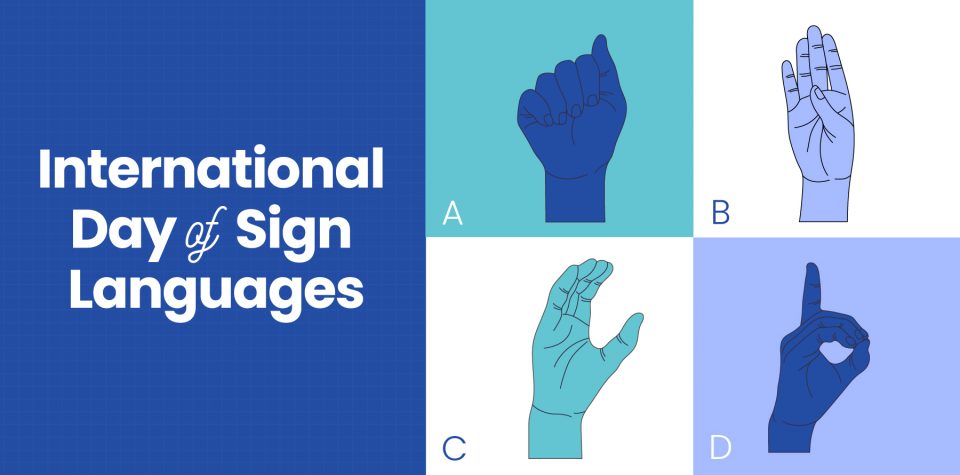
The Many Languages of Sign Language
Today is International Day of Sign Languages, a day to celebrate the intricate, beautiful ways that our 72 million deaf neighbors communicate without speaking. Instead they sign using hand and arm movements, facial expressions, and body positions.
Believe it or not, there are nearly 300 different sign languages! Here’s a look at just a few. Do you think they communicate “family” the same or differently? How would you sign it?
American Sign Language (ASL)
Between 250,000-500,000 deaf Americans use American Sign Language (ASL). In Canada, West Africa, and Southeast Asia, their sign languages are rooted in ASL, too.
See how to sign “family” in ASL.
There’s also a form of ASL called Pro-Tactile American Sign Language (PTASL), developed for deaf people who are also blind. It uses a variety of ways to communicate, including braille, spoken word, and object-symbols.
French Sign Language (LSF)
Much of ASL is based on French Sign Language, or LSF. Both use a one-handed finger spelling alphabet, for instance. LSF was one of the earliest European sign languages to gain acceptance by educators, which is why it has influenced many other sign languages across the world.
LSF flourished in the 1700s until “oralism” became all the rage in the late 1800s. Deaf students were then discouraged from signing in schools in favor of speaking French and reading lips. Teachers finally began using it again in the late 1970s, and in 1991, LSF was officially brought back into schools.
The French way to sign “family” is pretty much the same as the American way, since ASL is derived from LSF.
British Sign Language (BSL)
About 150,000 people in the UK use British Sign Language, or BSL. It evolved at Thomas Braidwood’s schools for the deaf in the late 1700s and then spread to Australia and New Zealand. Although all three use the same grammar, manual alphabet, and much of the same vocabulary, there are still many differences. For example, New Zealand Sign Language includes signs for Indigenous Māori words, and deaf Australians use some Indigenous Auslan signs, which are derived from Irish Sign Language.
Although British and American English are pretty similar, when it comes to sign language, they’re not even in the same language family!
See how differently they sign “family” in Britain.
Irish Sign Language (ISL)
Although most people in Ireland today speak English, the deaf in Ireland speak Irish Sign Language (ISL), which is derived from French Sign Language.
One interesting tidbit about ISL: Many deaf Irish students were educated in Catholic schools, which separated students by gender. That’s why for a while men and women each had their own dialects of ISL! Thankfully, those differences have diminished over time.
See how they sign “family” in Ireland. (Fast forward to :25 in the video).
Chinese Sign Language
Anywhere from one million to 20 million deaf people in China use Chinese Sign Language, but it’s difficult to know exactly how many because it hasn’t been used in Chinese schools for so long. Some schools for the deaf have opened recently, slowly growing its acceptance and use.
CSL has influences unique to Chinese culture and spoken language. For example, there is no one word for just “brother” in Chinese. You have to sign “older brother” or “younger brother.” Also the sign for “eat” obviously includes chopsticks.
See how differently they sign “family” in China, along with a lot of other fun words and phrases!
Mexican Sign Language (LSM)
LSM has its own vocabulary and grammar, independent from Spanish or even Spanish Sign Language. It’s more derived from French Sign Language, like the American version.
For the past half century, deaf children in Mexico learned the oral method. But in 2005, Mexican Sign Language was officially recognized as a national language alongside Spanish and indigenous languages. However, due to a shortage of teachers, few deaf students have access to it. In urban areas, kids and teenagers sometimes use a street slang form of signing that older signers don’t understand. (That sounds like teens and their parents in all languages.)
See how they sign “family” in Mexico.
Ask your friends and family to try to communicate the word “friend” using only their hands. Are there common movements that show up? Do they match any of the sign languages above or the one you imagined?
When we communicate, no matter what our language, our personal and cultural diversity comes through, from the words and phrases we choose to how we say them. It’s an adventure in expression, and we love that.
